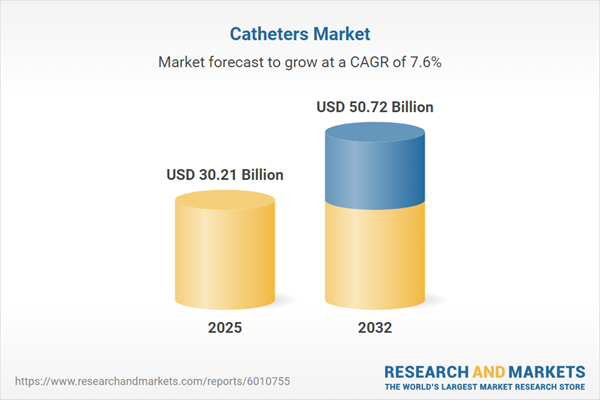Speak directly to the analyst to clarify any post sales queries you may have.
The catheters market is navigating dynamic transformation, driven by continuous innovation, evolving regulatory priorities, and shifts in healthcare delivery models. Senior leaders must recognize emerging opportunities across technologies, applications, and regions to chart effective growth and risk mitigation strategies.
Market Snapshot: Catheters Market Growth and Expansion
The Catheters Market grew from USD 28.19 billion in 2024 to USD 30.21 billion in 2025. It is expected to continue growing at a CAGR of 7.61%, reaching USD 50.72 billion by 2032.
Scope & Segmentation
- Product Categories: Cardiac, gastroenterology, neurovascular, suction, and urinary catheters, each supporting diverse clinical procedures and specialties.
- Catheter Types: External, indwelling, and intermittent self catheters addressing patient and care setting needs from long-term to self-managed use.
- Material Composition: Polymer, rubber, and silicone substrates optimizing flexibility, resilience, and biocompatibility for performance and patient comfort.
- Coating Options: Coated versions focused on microbial resistance and uncoated variants prioritizing simplicity and cost control.
- End Users: Ambulatory surgical centers, home healthcare, and hospitals & clinics, accommodating outpatient efficiency and acute care throughput.
- Applications: Diagnostic and therapeutic functions encompassing contrast delivery, drug administration, and fluid management in interventional care.
- Regional Coverage: Includes Americas (North America, Latin America), EMEA (Europe, Middle East, Africa), and Asia-Pacific, each exhibiting distinct regulatory and adoption dynamics.
- Key Companies Analyzed: Abbott Laboratories, Advin Group, ALVIMEDICA, Amsino International, Inc., Andocor, AngioDynamics, Inc., Asahi Intecc Co., Ltd., B. Braun SE, Becton, Dickinson, and Company, Boston Scientific Corporation, Cardinal Health, Inc., Coloplast A/S, Convatec Group PLC, Cook Group Incorporated, Freudenberg Medical, GE HealthCare Technologies Inc., Getinge AB, Hollister Incorporated, HR HealthCare, Johnson & Johnson Services Inc., Koninklijke Philips N.V., Lepu Medical Technology (Beijing) Co., Ltd., Medline Industries LP, Medtronic PLC, Merit Medical Systems Inc., Nipro Corporation, Olympus Corporation, Q3 Medical Group, Siemens Healthcare GmbH, Stryker Corporation, Surmodics, Inc., Teleflex Incorporated, Terumo Medical Corporation.
Key Takeaways
- Advanced catheter technologies are evolving in response to broadening use cases, expanded patient demographics, and clinical demands for minimally invasive procedures.
- Material science, device miniaturization, and next-generation coatings are shaping product design, driving improved performance for both acute and outpatient care settings.
- Integration of digital features and smart systems is strengthening clinician capabilities in visualization, precision, and outcome tracking during interventions.
- Sustainable manufacturing and increased use of eco-friendly polymers are gaining traction as organizations adapt to environmental and supply chain requirements.
- Strategic partnerships and localized manufacturing hubs are facilitating product adaptation to regional regulatory standards and clinical preferences.
- Distinct market segments—ranging from cardiac to neurovascular devices—call for focused research and development to address the requirements of each sector and drive competitive differentiation.
Tariff Impact: Navigating Policy-Driven Shifts
Heightened tariffs introduced in 2025 are prompting catheter manufacturers to recalibrate global sourcing strategies. Supply chain resilience is increasing through diversification of raw material sources, expanded regional partnerships, and localized value chain activities. These initiatives help mitigate input price volatility, ensure production continuity, and stabilize operational costs for downstream healthcare providers. Proactive adjustments to procurement and contract management frameworks are resulting in greater agility for both manufacturers and purchasing organizations working within constrained budgets.
Methodology & Data Sources
This research integrates structured interviews with industry leaders, clinicians, supply experts, and key regulators. Findings are supplemented by a thorough review of scientific journals, patent records, industry white papers, and regulatory filings. Quantitative techniques—including scenario modeling and thematic validation—ensure credible, actionable guidance for market participants.
Why This Report Matters
- Enables leadership teams to identify new market opportunities and anticipate emerging risks in the evolving catheters sector.
- Provides actionable intelligence to support investment in targeted R&D, supply chain resilience, and digital transformation strategies.
- Ensures informed decision-making through detailed segmentation, technology analysis, and regional growth projections aligned with current industry needs.
Conclusion
The catheters market remains shaped by innovation, global regulatory developments, and adaptive commercialization approaches. Executives are encouraged to leverage these insights to drive sustainable growth and competitive leadership in this dynamic medical device sector.
Additional Product Information:
- Purchase of this report includes 1 year online access with quarterly updates.
- This report can be updated on request. Please contact our Customer Experience team using the Ask a Question widget on our website.
Table of Contents
3. Executive Summary
4. Market Overview
7. Cumulative Impact of Artificial Intelligence 2025
Companies Mentioned
The companies profiled in this Catheters market report include:- Abbott Laboratories
- Advin Group
- ALVIMEDICA
- Amsino International, Inc.
- Andocor
- AngioDynamics, Inc.
- Asahi Intecc Co., Ltd.
- B. Braun SE
- Becton, Dickinson, and Company
- Boston Scientific Corporation
- Cardinal Health, Inc.
- Coloplast A/S
- Convatec Group PLC
- Cook Group Incorporated
- Freudenberg Medical
- GE HealthCare Technologies Inc.
- Getinge AB
- Hollister Incorporated
- HR HealthCare
- Johnson & Johnson Services Inc.
- Koninklijke Philips N.V.
- Lepu Medical Technology (Beijing) Co., Ltd.
- Medline Industries LP
- Medtronic PLC
- Merit Medical Systems Inc.
- Nipro Corporation
- Olympus Corporation
- Q3 Medical Group
- Siemens Healthcare GmbH
- Stryker Corporation
- Surmodics, Inc.
- Teleflex Incorporated
- Terumo Medical Corporation
Table Information
| Report Attribute | Details |
|---|---|
| No. of Pages | 195 |
| Published | November 2025 |
| Forecast Period | 2025 - 2032 |
| Estimated Market Value ( USD | $ 30.21 Billion |
| Forecasted Market Value ( USD | $ 50.72 Billion |
| Compound Annual Growth Rate | 7.6% |
| Regions Covered | Global |
| No. of Companies Mentioned | 34 |









